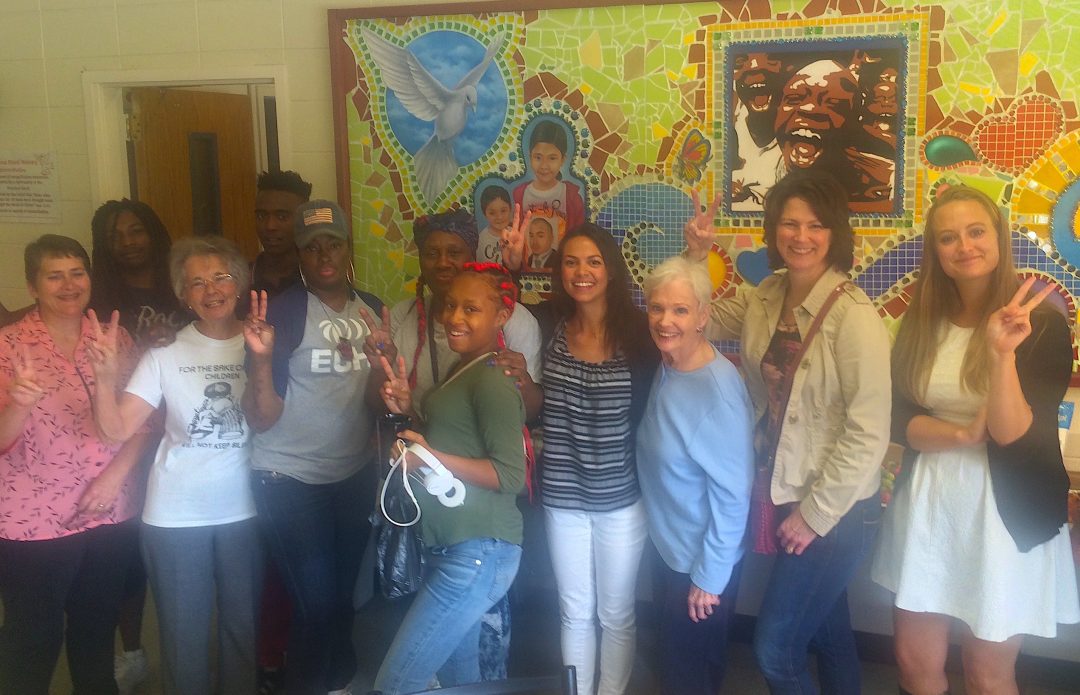Radical Collaborators: Co-Designing Grants with Our Partners
Categorized as: About us, Grantmaking strategy, Stories & Tagged as: Boards, Collaboration, Grantmaking, Strategy on February 10, 2018.

Editor’s note: This piece first appeared in our 2017 Annual Report.

By Suzanne Skees, Founder, Board Chair, and Storyteller
Our family believes that if you’re going to collaborate, you ought to begin by asking how you can help. We’ve restructured our entire grantmaking program to adapt to changes requested by the changemakers we’re privileged to support.
Unfortunately, we hear from our nonprofit partners that designing grants with rather than for them is as radical and rare as it is welcome.
In case our “radical” methods might prove useful to others, I’ll share here how we:
- Elicit blunt feedback from our partners,
- Change the way we do philanthropy, and
- Rally our family to debate ways to end poverty . . .
. . . All with nearly $0 administrative cost.*
1: Using Stealth and Surprise in Partner Selection
Since we’re too small and understaffed to review grant proposals, we’ve adopted a grantee-partner selection process that’s virtually all behind-the-scenes.—Thus, until a nonprofit receives a happy email from us, announcing our incoming, multiyear, unrestricted grant, they don’t even know we exist.
Here’s how we do it:
- Landscape survey: Year-round perusing of industry trends (see what we’re reading here) culminates in a springtime gauge of methodologies that have been tested, proved, or debunked in global efforts to reduce poverty through education and employment.
- Potential grantee database: We keep a database of nonprofits that could be a good match for our next grant cycle, sourced from social-enterprise and nonprofit incubators and contests, news and blogs we read, and most importantly, referrals from current partners. Because we fund tiny startups that may not be on any national or international radar, and because we’ve learned through experience that strong leaders matter more than clever ideas, we source our best future partners through the grassroots connections of our current ones.
- Due diligence: We DIY due diligence. Rather than commanding long forms and reports from nonprofits, we conduct an efficient online search of their mission, impact, people, and financials. Now and then, we might reach out to an unknown possible-partner to request budget details.
- Staff selection: Our small family staff, in conjunction with objective social-impact professionals, culls our list from as many as one hundred options to around fifteen finalists, whose solutions to social inequity and poverty seem especially fresh, viable, sustainable, and scalable.
- Board consensus: Our board of six family members across three generations studies the finalists, weighs our options against a matrix of ten values (such as targeting ultra poor, being obsessed with mission, and using technology to extend reach), reaching for geographic (global) and population (all ages and genders) balance.
- Grant investments: We select 5-8 new or nascent “Seed” grantees and 2-3 stable and scalable “Catalyst” grantees (read more about all types of our grants here). And then, the real work of being their partner begins . . .
2: Eliciting Blunt Feedback That Helps Us Grow
We keep asking: How can we improve our side of this partnership? We elicit feedback from all around us:
- Partners: Annual feedback loop from conversational surveys (see below), anonymous reviews on GrantAdvisor, and open conversations with partners.
- Clients: Site visits to programs and client interviews for stories, to deepen our own understanding and advocate through storytelling.
- Board: Annual retreats at which we evaluate our progress as individuals and a team, review feedback from partners, and implement into concrete changes.
- Family: Dinner-table conversations on equality and equity, reunion meetings on the mission and strategy of SFF.
When we hired a strategic consultant to ask this question for us, we really began to learn. Their objective survey of current SFF partners, launched as an experiment the first year, has now become a cornerstone of our programming. They schedule thirty-minute conversations with each grantee partner, once per year, to ask about key accomplishments and challenges this year, major goals for next year, and what partners need. Then they ask, “How could Skees do better in this partnership?” Results from this portion of the survey are 100 percent anonymous, and we take them very seriously.
3: Adapting Our Grants
When our board receives the results, we pore over them obsessively; and each year, we make concrete adjustments based on this feedback. For example:
- We launched a private Facebook forum where our partners can communicate anytime, from anywhere, about their challenges and ideas.
- We did a 180-degree turnaround in how we source stories for our Seeds of Hope blog when partners admitted to feeling pressured to provide input; now, we find and write all material rather than asking them to do so.
- And perhaps most importantly, we modified the very structure of our grants:
- All grants are now multiyear (two-year) and completely unrestricted.
- All reporting is conducted via one brief annual, informal, third-party, telephone survey.
- We phased out grants with mediocre outcomes—i.e., partner and storytelling grants. Read more about our current grant types here.
Over time, our partners have begun to trust that we really want to know them better. So, more and more, they tell us what they’re really thinking.
Also, traveling with and to our partners’ U.S.- and global-based offices, conversing with staff and clients, has made an enormous difference. SFF is too small to fund site visits, so we reach into our own pockets to pay for site visits.
4: Remaining Hands-Off, Yet Available
As we note with each grant we send: “We are honored to continue to support you, and we require nothing of you but that you continue your worthy work. Please don’t hesitate to reach out if we can assist you in any other way-listening, offering feedback and moral support, co-creating stories, matching you to colleagues, or anything else in our capacity.”
We believe our role is to invest, then trust.
When asked, we’ve provided programmatic and strategic advising, sharing stories of partners’ innovations and impact, matching grants and industry matchmaking. We advocate for our partners in other grant contests and applications. And we get partners together, in–person or onscreen, to share solutions to such challenges as technology in rural areas, corruption in government and (sometimes) in-house, and chronic shortages of hours in the day and dollars in the bank.
5: Counting Every Dollar
When we took a hard look at our financial forecast and realized we were careening toward unintentional spend-down (resulting from a post-Recession corpus further shrunken by large multiyear grant commitments), we sought feedback from our board and advisors.
Confronted with the choice of succession or spend-down, we chose a hybrid plan we dubbed “spend-freeze.” We’re now maximizing our grants by giving to smaller startups and moving more of our corpus into social-impact investments, while shrinking our already-low expenses.
How? By not paying rent for offices or retreats, offering substandard pay for our two part-time staffers, and extracting more volunteer work from our board members. We “pay” ourselves once a year at our board retreat with a sumptuous dinner (this year, an Indian banquet) and a gift (this year, a fair-trade ornament from Haiti).
Because of our minuscule budget, we use a lot of distance technology. Our staff meetings reach from New York to California to Korea via Skype or Google, and our board meetings create a conference table over Zoom.
We meet with our partners via videoconference, during board meetings and retreats, passing the laptop around to introduce each of us and asking them to do the same from places we long to visit in person as well: Bangladesh (JAAGO Foundation), Rwanda (Akilah Institute), Haiti (Anseye Pou Ayiti/Teach for Haiti), and India (Upaya Social Ventures).
We ask them to tell us what it’s like doing their work in that place, what motivates them and nourishes them, what angers and discourages them, and what vision of the future drives them to keep striving toward their mission. We tell them, “You’re part of the Skees family, now and always.”
To extend the introductions to the rest of our extended family, we post recorded videos of these partner meetings privately, so the partners and children, cousins and grandparents, can watch anytime.
Our fiscal discipline has allowed us to give almost as much as we currently hold: We’ve given $1.86 million in grants and manage a current corpus of $2.4 million.
6: Adapting Family Engagement
Using feedback from our family and board, we also redesigned our family grants this year:
- We phased out our “local 2 global” individual discretionary grant based on volunteer hours logged, in favor of . . .
- Expanding our “family grant” program to include “aging-in” members of our third generation and a more expansive, inclusive definition of “who is family?”
- And, we invented a new “generational grants” program (see page 2) that gets peer members of each generation working together to research, debate, and select on-mission grants.
As more family members become more knowledgeable and engaged, we all discover the joy of striving together to create a more equitable world. Extended families bond over all sorts of activities, such as cooking, golfing, or traveling . . . We definitely enjoy our playtime; however, collaborating through SFF elevates us to our higher selves. We end up inspired by each other’s passion and amazed over our partners’ accomplishments.
7: Re-Checking Our Compass
What motivates our family has remained consistent over time. We’ve discovered that it’s the same in 2018 as in 2004 (although this was completely unintentional):
We believe all humans are created equal and deserve equal opportunity to build lives of prosperity and choice. Our compass will always be this core value, which is reflected in our mission statement to support self-help programs in education and job-creation to youth and families to end poverty worldwide.
*Our expenses include sub-par/part-time salaries for two family staffers, accounting and financial management, low-budget contracts for website and strategic planning, flights to our annual board retreat, and fees for Dropbox and Zoom.
Got feedback for us? We’d welcome your ideas about how to improve our approach to grantmaking. Also, if you’re a past or present portfolio partner of SFF, please rate us anonymously on GrantAdvisor.
LEARN more about our amazing grantees here.
SHARE this story on Facebook and Twitter; see menu at top and bottom of page.
SUBSCRIBE! Like what you see? Click here to subscribe to Seeds of Hope!
